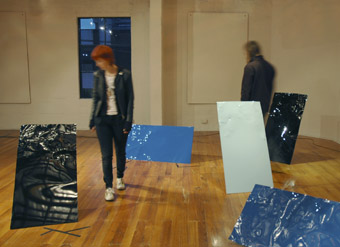mind-reading in the 21st century
chris reid: chesworth & leber’s space-shifter

Space Shifter, David Chesworth, Sonia Leber, Conical Gallery
image courtesy the artists
Space Shifter, David Chesworth, Sonia Leber, Conical Gallery
AS YOU ASCEND THE NARROW STAIRS TO CONICAL GALLERY, YOU OVERHEAR A JUMBLE OF VOICES—SQUEALING, GROANING, CRYING, LAUGHING AND SINGING, SOMETIMES IN CHORAL HARMONY, SOMETIMES MIXED AND MORPHED, AND CONTINUOUSLY RISING AND FALLING. ONCE INSIDE, YOU ARE GREETED BY THE VISUAL ELEMENTS OF SPACE-SHIFTER—10 RECTANGULAR SHEETS OF METAL, EACH ABOUT 60 X 150 CM, PROPPED UP ON THE FLOOR AT AN ANGLE, EITHER SIDEWAYS OR LENGTHWAYS. FIVE PANELS ARE GLOSSY BLACK, THREE ARE A PALE OR MAYBE SKY BLUE, AND TWO ARE A DARKER BLUE. THE PAINT IS CAR DUCO, CLEAN AND SHINY, BUT EACH PANEL BEARS NUMEROUS DENTS AS IF IT HAS BEEN BATTERED FROM BEHIND WITH A SHARP, HEAVY INSTRUMENT, AND THE DUCO APPLIED AFTER THE BEATING TO SEAL IN THE MARKS.
In a corner of the gallery is an inverted metal bowl, about two metres across, tan or khaki in colour. Prior to painting, the bowl has also been dented and then roughly cut into 3 pieces to make it look cracked, like crockery or an eggshell or perhaps like a military helmet bearing fatal damage; and it is intriguingly bent at one edge to suggest it has been thrown vigorously into the corner of the room.
Space-Shifter thus presents a series of riddles for the viewer-listener. The sound comes primarily from four loudspeakers mounted high out of sight in the corners of the room, and the signal moves suddenly back and forth between the speakers, detached from any specific location. This dialogue is augmented by low rumbles that come from some of the metal panels, which turn out to have transducers attached, and even from the floor itself. Initially, you wonder if your presence is triggering the abrupt changes in the dynamics or direction of the sound (a strategy that is almost expected these days). But it turns out that you’re hearing a pre-recorded multi-channel tape loop of a choir (the Royal Melbourne Philharmonic Choir), and there is a large transducer attached to the floor that creates the subtle resonance you feel in your body. The work recreates the cacophony of the mind, recalling extreme emotional states. Ultimately, the sound is disembodied—shifting—so that, as you locate yourself in visual space you lose your bearings in aural space, creating feelings of uncertainty and even dread.
The metal forms initially seem disconnected from the sound. They occupy and disrupt the gallery space, drawing upon the idea of minimalist sculpture in the form of iconic shapes and colours. They suggest industrial fabrication bearing the signs of damage through misuse and abuse. The colours suggest fundamental substances such as oil, earth and air, or darkness and light, but represent a civilised world whose scars are painted over. And they are loudspeakers voiced as instruments, as is the gallery itself, to distort the sound. Overall, Space-Shifter functions as an audio-visual Rorschach inkblot in 3D. This is conceptual art that works in cycles of evaluative and experiential contemplation, testing the pull of our own subjectivity.
Visual artist Sonia Leber and composer David Chesworth have collaborated on numerous projects over many years, creating immersive environments, sometimes in public places, as in 5000 Calls (Sydney Olympic Park, 2000) and sometimes in the closed environment of the art gallery. They frequently use recordings of vocal sounds as an index of human activity and emotional reaction, sometimes recalling Hugo Ball’s Dadaist recitations at Cabaret Voltaire, and even the Tower of Babel. The Space-Shifter composition is best absorbed with eyes closed, even though this temporarily occludes the sculptural component of the work, as principal vocalists Jerzy Koslowski and Deborah Kayser contort their voices to create an intense aural drama. Ideally, you listen alone, but if other viewers are present, their whispering and shuffling merge into the soundscape.
In the program note for Space-Shifter, Leber and Chesworth suggest that the work is a psychogeography of voice and space. Psychogeography was a theme of interest to Guy Debord of the Situationniste Internationale movement of the 1950s, which critiqued urban life. Debord was especially concerned with the ways architecture locates and defines the individual in psycho-social space, a recurring theme in Leber and Chesworth’s art. Their notes also refer to our feelings of metaphysical anguish on hearing a disembodied voice, particularly a voice whose utterances make no sense. The human voice is the central element in this work, mimicking the tones of your own internal dialogue with all of its fears, desires, laughter and grief. The sound-track by itself is troubling enough, but the addition of the sculptural forms, signifying architecture that speaks, makes the work that much more harrowing.
Sonia Leber & David Chesworth, Space-Shifter, Conical Gallery, Melbourne, May23-June 13
RealTime issue #92 Aug-Sept 2009 pg. 50






